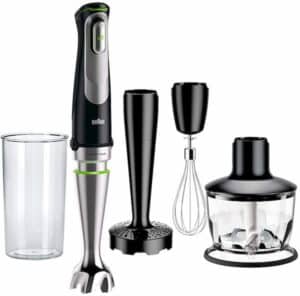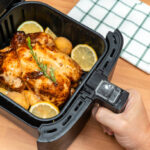
They eliminate all the hustle and bustle involved when dealing with large and noisy appliances. However, it is not until you purchase a stick blender that you realize how vital it can be in your home.
It has moderate dimensions and can be stored easily in any drawer, and is relatively light; you can use it with one hand. Besides, it has a simple design that allows users to perform various blending tasks directly in a cooking pot, bowl, or any other convenient container. Finally, it is far simpler to clean than the countertop, personal blender, or most other kitchen appliances.
Read More: KitchenAid K150 Blender Review | 3 Speed Ice Crushing Blender
It is worth noting that not all hand blenders found in the market are practical and convenient. Therefore, there are some essential qualities you need to reflect on before purchasing your best Immersion Blender. However, as long as you need an excellent immersion blender, you should consider some crucial parameters this immersion blender buying guide specifies.
Table of Contents
Functionality
Functionality is a crucial factor to consider when buying stick blenders. Typically, they need to be there in the kitchen to prepare your hearty recipes, for instance:
- Making the creamiest Soup directly in the cooking pot;
- Besides, you can blend any hot ingredients with it, including Bulletproof Coffee;
- Within five minutes, you can comfortably make homemade salad dressing easily prepare a variety of sauces, dips, and pesto, or mayonnaise, and it is perfect for light blending tasks;
- Emulsifying a Tomato Sauce;
- Making Baby food is another task where an immersion blender excels;
- Mashing potatoes and puréeing vegetables can be quickly done in under a minute without any effort from the user side;
- Whenever you think of whipping up creams, and the immersion blender makes this possible, several whips of foamy beverages do this with little effort;
- You can still reach your hand blender when beating eggs to make omelets or whenever you need a fluffy egg as part of your cooking;
- Essentially, you can mix up pancake batter if your recipe demands it;
- Besides, it can surprise you when you require to make milkshakes and smoothies; remember it will handle only softer ingredients;
- Chopping cheese, breadcrumbs, and even small portions of meat.
Immersion Blender Wattage
The immersion blenders are designed for light blending, whisking, mashing, and chopping tasks, and this determines the wattage of immersion blenders, which usually ranges from 150W-600W.
Generally, if you require this gadget for light blending, a 200–350 watts blender will serve the purpose, while heavy-duty immersion machines will feature up to 1000 watts. However, some commercial-style immersion blenders, such as Bamix, come with moderate wattage of 200–400 watts; still, they are perfect for what they are designed for since other construction parameters allow them to perform heavy-duty tasks.
Maximum Running Time
Before buying this gadget, it is also vital to know that the majority of Immersion blenders are designed for 10 seconds to 1 minute of continuous operation and must be cooled for a few minutes before you start operating them again. This running time is generally enough as this type of blender is intended for light and the quick task where you can conveniently use them in the cooking pot or the glass.
Typical Attachments and Accessories
For efficient working of this hand machine, the attachments or accessories are vital complements. These are the essential attachments that accompany a typical immersion blender:
- Star blade head (s‑blades) is the standard attachment for all types and brands of immersion blenders. It is suitable for most of the homogenizing chores such as making soup or preparing a variety of dressing and sauces recipes; it is also can be used for shredding and mincing meat;
- The Whisk head is designed for whisking and whipping tasks and also for mixing essential cake recipes;
- Masher is used for mashing potatoes and other cooked vegetables and fruits;
- The Mini Chopper is the standing bowl fitted into it the central blender unit; it is designed for light chopping dry tasks. The food processor has a very similar chopping attachment design but has a giant bowl and stronger blades and performs heavier tasks such as making hummus and thick dips;
- The Frothing Blade head is intended for frothing milk and can mix basic batter;
- Beaker is a container where you can blend your recipes.
Similarly, other minor attachments might not be very essential but can still be included in the stick blender’s pack:
- A Splash Guard fitted on the arm of the blender and guarded the splashing against the beaker;
- The Beaker lid makes the beaker a storage container;
- Pan Guard is a plastic rim fitted with a metal bell head to prevent the nonstick pans from scratching.
It is typically, the more expensive gadgets come with a greater selection of attachments and accessories. Nevertheless, a high-quality food product can be made whenever the minimal selection of attachments or accessories is used skillfully.
Speed Settings for Stick Blender
The basic Immersion blender may have only one speed, which is activated with a press-and-hold button. The more sophisticated models come with two and more speeds, including variable and turbo speed selections.
Operating
Stick blenders are easy to assemble and use. For example, if you need to prepare food or a drink, an immersion blender can conveniently reach cooking pots or bowls. Moreover, most stick blenders are automated, enabling you to precisely prepare your recipe. For instance, when you increase the pressure on some immersion blenders’ triggers, they automatically increase their speed.
Others go to the extent of warning you against blending hot food and drinks. Anti-suction technology has also been applied in most modern models. This technology helps prevent the food content from spilling out of the cooking pot or a bowl when blending.
Cleaning
Most stick blender has a removable shaft, which is about 8–12 inches. The main advantage of the removable shaft is to clean the gadget in an easier way. Thorough cleaning is possible since the shaft can be removed from the blender’s body and cleaned separately. Besides, a hand blender has a removable blending head and other attachment parts. Most of the removable immersion blender parts are dishwasher-safe.
Corded and Uncorded
Most immersion blenders are hard-wired, but some of them come with removable cords and rechargeable batteries. Although the cordless machines have better maneuverability but are heavier and have less wattage. At the same time, corded blenders are more robust and more powerful.
The Material It Is Made
The immersion blenders usually have stainless steel blades, heads, and plastic bodies. The commercial types of immersion blenders may have metal shafts. The steel material increases the durability of the hand blender. The containers usually are plastic and sometimes glass.
The more stainless steel in the immersion blender design, the easier it is to clean because you only need hot or warm water and mild detergent to make it clean. You need not worry whenever you are working on hot or even boiling soup using a hand blender with steel material. The safety of your stick blender is guaranteed since the steel part can’t melt. Such durable materials protect the stick blender from cracking or even warping.
Although plastic material is also easily cleanable, it may leave unremovable stains after processing such ingredients as carrots or beets. Plastic is also not always safe to use with hot ingredients.
Brands
There is a large variety of Immersion blenders available on the market nowadays. Some of the most trusted gadgets on the market include KitchenAid, Braun, Cuisinart, Breville, Smeg, Bamix, Waring, All-Clad, and Hamilton Beach; they are usually well-made, come with a warranty, and demonstrate excellent performance. Unfortunately, the brands you never heard of before are generally produced in China; they are much cheaper than reputable brands, but they typically do not last for long and often come without a warranty and non-existent customer support.
Among the reputable brands, some KitchenAid and Braun models are easily affordable, and they are known for their high-performance levels. If you go for a reputable stick blender brand, you are guaranteed to get its accessories on the market quickly, and their warranty will be served. For instance, if one addition breaks down, you can easily replace it instead of purchasing a new hand blender.
Price
Whenever a customer thinks of buying an item, the first question that hits their mind is the cost. Do not worry if you are planning to purchase an immersion blender. There are countless affordable brands available in the market. Even with a tight budget, you can easily buy one according to your choice. Their prices are determined by design, motor power, number of accessories, and the material used to make them. With as low as $60, you can get a quality model. While the premium models may cost over $200, they usually will have a stylish stainless steel construction, a wider variety of attachments, and commercial blender-level performance.
Summary
Finally, if you look for an appliance that performs a variety of light-duty blending tasks, then an immersion blender is the right option. It may replace a few kitchen appliances, it is effortless and convenient to use, and they are more affordable than full-size blenders. As long as you buy a quality immersion blender, your cooking will be defiantly made easier. Before going for a stick blender, carefully consider the above buying guides for you to purchase the specific blender that will serve your purpose.




Is there any brand with a blender head attachment that is smaller than 2 inches or 5cm? I’m trying o fit one of these into a standard wide mouthed nalgene bottle.
Hi,
Most reputable brands’ immersion blender head diameter is 3” or bigger. However, you may find among the generic Chinese brands the blender with smaller heads. It seems Makoloce 800W hand blender and KOIOS 800W 3‑in‑1 Immersion Hand Blender may fit your requirements for the head size. I advise you to contact the manufacture and confirm the size of this parameter is very important to you.
I hope, it helps.